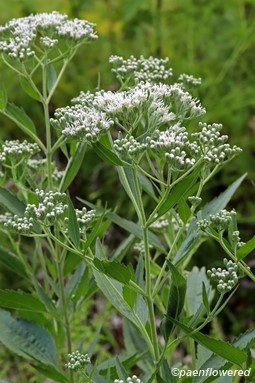Eupatorium serotinum
Eupatorium serotinum late thoroughwort
There are several species of thoroughworts in the eastern United States. This plant is considered adventive in Pennsylvania and is almost as abundant as boneset. Boneset, however, blooms earlier in the season and usually in moist areas. Joepye weed and white snakeroot until recently were also in the genus Eupatorium, but have since been moved. In many ways, though, the late thoroughwort resembles boneset and white snakeroot because both produce dense rounded clusters of fuzzy white composite flower heads. Thoroughwort, however, is a larger and more branched plant, often grows in drier areas and does not have a stem that seems to penetrate a pair of clasping leaves, as is the case in common boneset. Thoroughwort often has the appearance of a small shrub.
The leaves of the thoroughwort are long-stalked, toothed and more linear than the heart-shaped leaves of white snakeroot. These leaves are usually 3-veined and occur in pairs or whorls. The leaves are lightly hairy. The stem is quite hairy and often red in color. Each flower head has from nine to fourteen tiny white individual flowers. The bracts under the flower heads have white margins. Butterflies and bees use flowers as a source of nectar.
The plant grows in low thickets, along roadsides, and in clearings and moist woods. The height range of the plant is 3-7 feet. It is found south of a line from Minnesota to Massachusetts. It normally blooms in September and October. It is also called the late boneset. The similar tall thoroughwort (E. altissimum) is also common, but can be distinguished by its leaf stalks that are short or absent.
Habitat & Range
Grows in moist thickets, ditches, sandy fields and along roadsides. Prefers full sun and well-drained soil.
See distribution map at BONAP.
| EMP: | FAC |
|---|---|
| NCNE: | FAC |
Phenology
Flowers late August to October.
Characteristics
Inflorescence corymb-like panicles ; white florets, 9 -14 per head
Leaves simple, opposite, lanceolate, acuminate, coarsely serrate; petioled;
Stems 6½′ long; puberulent; often red in color
Height 3-6½ feet
Plant Codes
S-rank: No Rank
G-rank: G5 (Secure)
Ecology
Source of nectar for butterflies and bees.








Comments
Have you spotted this plant in your area? We'd love to hear about your experience! Share your comments or questions about the plant below. Comments are moderated before posting.